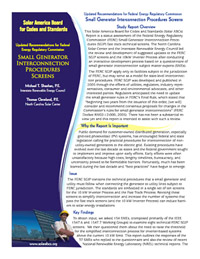
Solar ABCs Updated Recommendations for Federal Energy Regulatory Commission Small Generator Interconnection Procedures Screens
Download the one-page summary (PDF, 291KB) or the full report (PDF, 2.7MB).
Overview

Why the Report is Important
Public demand for customer-owned distributed generation, especially grid-tied photovoltaic (PV) systems, has encouraged federal and state legislation calling for practical procedures for interconnection of non-utility-owned generators to the electric grid. Existing procedures have evolved over the last decade as states and the federal government sought to implement and improves upon early efforts. Early efforts were often unsatisfactory because high costs, lengthy timelines, bureaucracy, and uncertainty proved to be formidable barriers. Fortunately, much has been learned during the last decade and "best practices" have begun to emerge.
Issue
The FERC SGIP contains the technical procedures that a small generator and utility must follow when connecting the generator to utility lines subject to FERC jurisdiction. The standards are embodied in a single set of ten screens for the 10 kW Inverter Process and the Fast Track Process. Revising these screens to simplify interconnection and increase the number of systems that pass the fast track screens (and the 10 kW Inverter Process) can reduce barriers to solar energy installations.
Solar ABCs Recommendation
Solar ABCs presents these recommendations with the intent that they will serve as the first step toward the update of the FERC SGIP. FERC and National Association of Regulatory Utility Commissioners (NARUC) should collaborate to update the following FERC SGIP screens.
- Screen 2.2.1.7: The limit placed on the size of the aggregate generation on a single phase shared secondary should be updated to be in terms of a percentage of the transformer nameplate rating.
- Screen 2.2.1.9: The stability requirement should be rewritten for clarity.
- Screen 2.2.1.3: Area networks should be covered in addition to spot networks. In addition, limits on maximum load should also be revised upward in keeping with recent rules enacted in Connecticut and by Consolidated Edison in New York and with the guidelines defined in the IEEE 1547.6, which went to ballot in mid-June 2010.
For the following screens, the survey results did not reach consensus, but many respondents made strong arguments for updates:
- Screen 2.2.1.2: Further investigation and research is needed to determine whether to increase (and by how much) the current 15% limit on generating capacity related to circuit peak load (or possibly to change the limit to a percentage of the circuit minimum load). Separate treatment of inverter-based generation should be considered. DOE or NREL should aggressively study these issues.
- 10 kW inverter process: Further dialogue and investigation is needed to determine whether to increase the limit from 10 kW for the simplified inverter interconnection process (and if so, by how much).